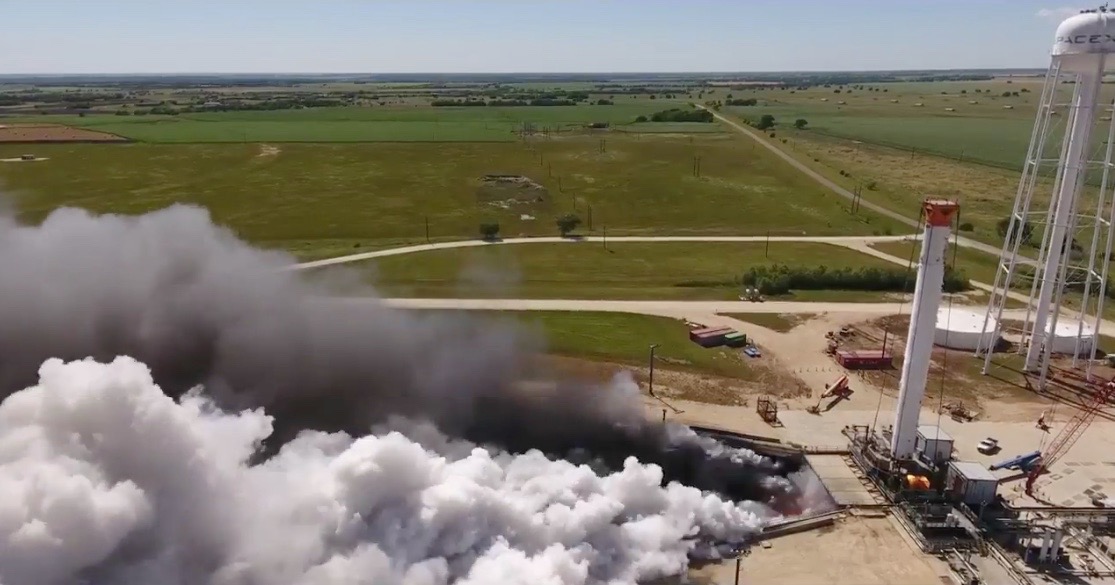
SpaceX just notched a big milestone in the development of the company's powerful new Falcon Heavy rocket, which is scheduled to fly for the first time a few months from now.
"First static-fire test of a Falcon Heavy center core completed at our McGregor, TX rocket-development facility last week," SpaceX representatives wrote on Twitter today (May 9), as an accompaniment to an 18-second video of the rocket test.
When ready to go, the two-stage, 230-foot-tall (70 meters) Falcon Heavy will be able to launch 60 tons (54 metric tons) to low-Earth orbit and 24 tons (22 metric tons) to geostationary transfer orbit. It will therefore be the most powerful booster since NASA's Saturn V moon rocket, SpaceX representatives have said. [SpaceX's Falcon Heavy Rocket in Images]
The Falcon Heavy is based on SpaceX's Falcon 9 rocket, which has been launching payloads to space since 2010. The heavy lifter's first stage consists of two Falcon 9 first stages strapped to a center core, which itself is a modified Falcon 9 first stage.
Falcon 9 first stages are powered by nine Merlin engines, so 27 Merlins will get the Falcon Heavy off the ground. The heavy lifter's second stage harbors a single Merlin, just like a Falcon 9 second stage.
Integrating these parts into a single rocket sounds simple, but it turned out to be "shockingly difficult," SpaceX founder and CEO Elon Musk told reporters on March 30. He was speaking during a teleconference after the company's successful launch of the SES-10 communications satellite.
But now, after years of work, the Falcon Heavy is nearly ready to fly.
Get the Space.com Newsletter
Breaking space news, the latest updates on rocket launches, skywatching events and more!
"Our expectation is probably a late-summer launch of Falcon Heavy," Musk said during the March 30 telecon.
That maiden flight probably won't carry anything too valuable, because the launch will be pretty risky, Musk added.
Like the Falcon 9, the Falcon Heavy will be a reusable vehicle; SpaceX has said it aims to land all three first-stage "cores" after each mission and re-fly them. The company may also try to recover Falcon 9 and Falcon Heavy second stages eventually, Musk has said.
The Falcon Heavy's first flight will feature two "flight-proven" Falcon 9 first stages, Musk added during the March 30 telecon. To date, SpaceX has successfully landed such boosters 10 times and re-flown one of them. This latter milestone occurred during the SES-10 launch.
Follow Mike Wall on Twitter @michaeldwall and Google+. Follow us @Spacedotcom, Facebook or Google+. Originally published on Space.com.
Join our Space Forums to keep talking space on the latest missions, night sky and more! And if you have a news tip, correction or comment, let us know at: community@space.com.

Michael Wall is a Senior Space Writer with Space.com and joined the team in 2010. He primarily covers exoplanets, spaceflight and military space, but has been known to dabble in the space art beat. His book about the search for alien life, "Out There," was published on Nov. 13, 2018. Before becoming a science writer, Michael worked as a herpetologist and wildlife biologist. He has a Ph.D. in evolutionary biology from the University of Sydney, Australia, a bachelor's degree from the University of Arizona, and a graduate certificate in science writing from the University of California, Santa Cruz. To find out what his latest project is, you can follow Michael on Twitter.









